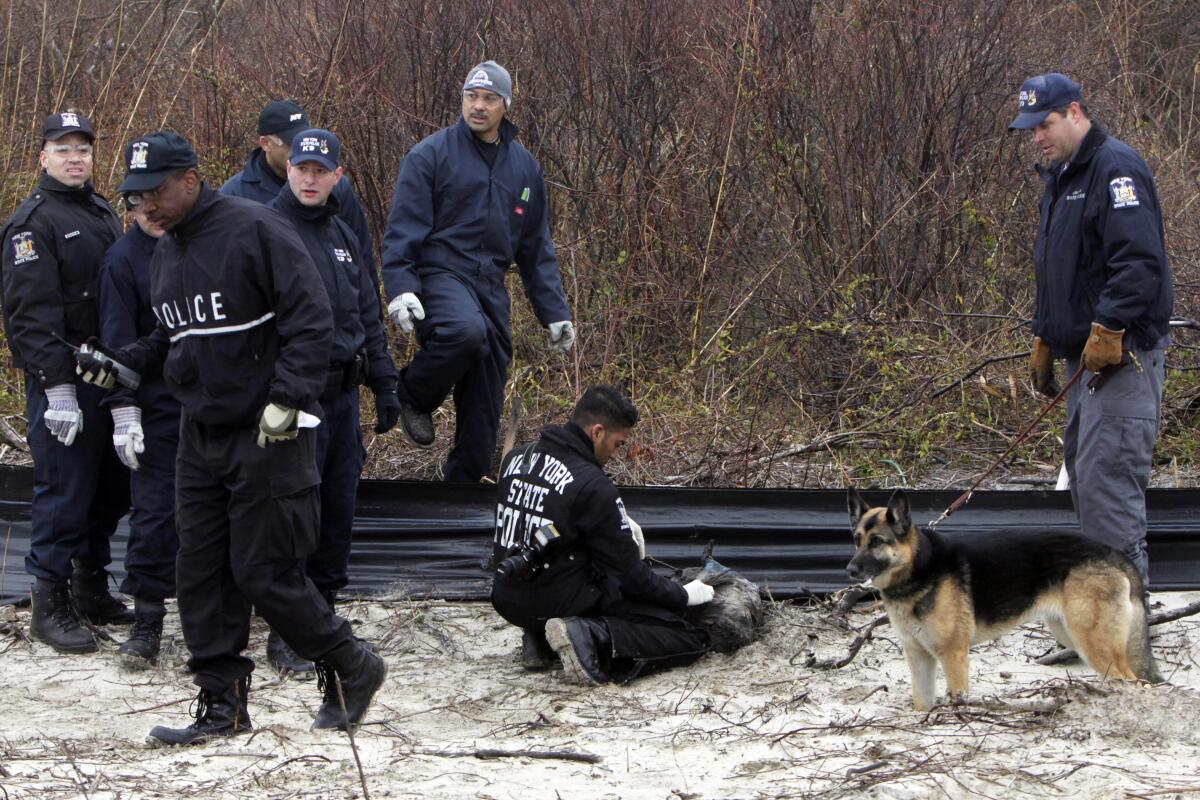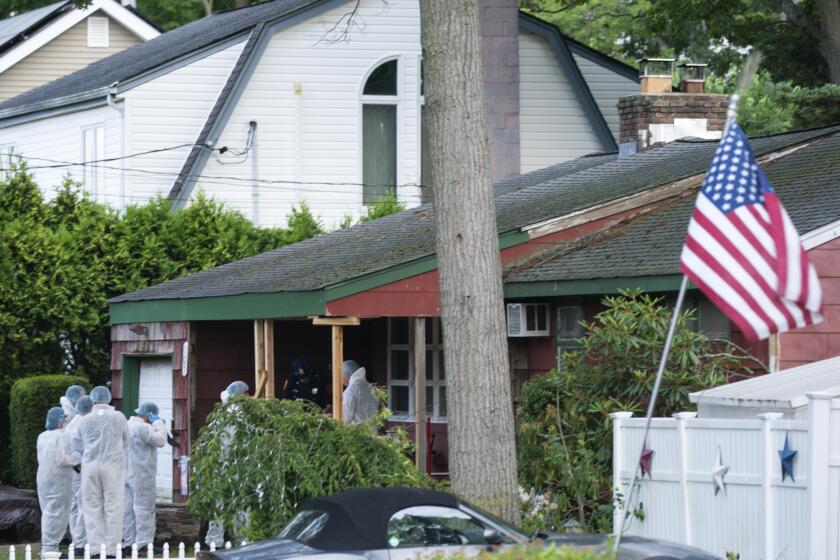Arrest of suspect in Long Island serial killings brings both pain and relief to victims’ families

- Share via
NEW YORK — The trail had gone cold as clues suddenly dwindled. For a time, doubts swirled about whether a killer who dumped the remains of his female victims along remote stretches of coastline on New York’s Long Island would ever be caught.
Then finally, after more than a dozen long years, bereaved families of the victims were provided with a whiff of relief Friday when authorities announced the arrest of a 59-year-old architect who they believe is responsible for their deaths.
The arrest rekindled anger and grief — but also brought the prospect of closure — for family members including Amy Brotz, whose cousin, Melissa Barthelemy, was the first of the victims to be discovered, found accidentally during a search for another woman.
“I can’t wrap my head around this,” Brotz said, just hours after being startled by the unexpected news of an arrest.
“God has brought peace to the families,” she said. “Maybe we can start the healing.”
A suspect has been taken into custody on Long Island in connection with long-unsolved killings known as the Gilgo Beach murders.
The years-long ordeal was especially unnerving for Brotz and her family because prosecutors say the suspect used Barthelemy’s cellphone to torment her relatives with calls soon after her disappearance, including one in which he said he’d killed her.
To accelerate the search for Barthelemy’s remains, her family hired a psychic, who provided tantalizing clues that would prove prophetic: She would be found in a shallow grave along the shore, near a sign with the letter G.
Gilgo Beach would become the focal point of the long-stalled investigation into the discovery of 11 sets of remains, including that of a toddler, all discarded along the parkway that cuts the length of a thin strip of white sand, dirt, brambles and marshes known as Jones Beach Island. The toddler and three other victims have yet to be identified. All 10 adult victims, including the toddler’s mother, were sex workers, police said.
But investigators say the suspect, Rex Heuermann, 59, might not be responsible for all of the deaths. In addition to the Barthelemy case, he has so far only been accused of killing two others, Megan Waterman and Amber Costello, who were reported missing in 2010. He is also the prime suspect in the death of a fourth woman who disappeared that same year, Maureen Brainard-Barnes. Heuermann says he is innocent, according to his lawyer.
Barthelemy, who grew up in Buffalo, N.Y., was found on Dec. 11, 2010, more than a year after she went missing. Two days later, the bodies of three other young women were found nearby.
Clues included strands of hair, the burlap used to wrap the bodies and a belt embossed with possible initials.
And there were the phone calls, including one made from Barthelemy’s cellphone on the day she was last seen alive that would be traced to the Long Island town of Massapequa, about 20 miles from where her body would later be found, not far from Heuermann’s house.
If convicted on all charges, Heuermann would face multiple life sentences without the possibility of parole.
“I’d like him to suffer at the hands of other inmates,” the victim’s mother, Lynn Barthelemy, told NBC News.
“Death is too good for him,” she said.
But she also expressed relief that a suspect was finally in custody.
A key question lingers, however: Why did it take so long? That was a question the suspect apparently had too: Prosecutors say he went online to ask, “Why hasn’t the Long Island serial killer been caught?”
Waterman was found near Gilgo Beach in December 2010, six months after she boarded a bus from Maine to New York. But her mother, Lorraine Ela, died last year never knowing if her daughter’s killer would be found.
Ela’s hopes were buoyed three years ago when investigators discovered new evidence: a belt embossed with two letters that might have belonged to the suspect.
“I can only be positive about it all,” she told Portland TV station WGME in January 2020.
Nicole Haycock, one of Waterman’s longtime friends and her brother’s former girlfriend, was surprised by the announcement of Heuermann’s arrest Friday. At first, she thought it was a hoax.
“There’s so many questions I still have,” she said, including, “Why her?”
Seven of the 11 victims whose remains were found on Jones Beach Island were not mentioned in the charging documents for Heuermann. Among them: Jessica Taylor, a 20-year-old Washington, D.C., woman who went missing in New York in July 2003.
Outside the courthouse where Heuermann was arraigned Friday, her cousin Jasmine Robinson remarked that “full justice” would be achieved only when all the cases were solved.
Robinson also hoped Taylor would be “remembered as a beautiful young woman, not what her occupation was at that time.”
Another unmentioned victim was Valerie Mack, who was 24 when she last left her family’s home in Port Republic, N.J.
Some of her remains were first discovered in 2000 in Manorville, N.Y., about 50 miles east of where more of her remains were discovered on Gilgo Beach more than 10 years later. Initially known as Jane Doe No. 6, she remained unidentified until genetic testing revealed her identity just three years ago.
The family tried to report her missing, but police convinced them that she probably ran off and didn’t want to be found.
“As far as we knew, she was still missing,” said her sister Danielle Mack. “We knew that something was wrong because ... we just don’t believe she would have never come back after 20 years.”
Mack said the family was stunned by the news of an arrest.
“It’s a lot to process,” she said, adding that she doesn’t know what to make of the fact that Heuermann wasn’t charged in Valerie’s death.
“I’m just waiting for all the other facts to come out for us to really understand what happened and who’s responsible,” she said, “and hopefully the right person is being brought to justice.”
There have been conflicting theories about whether Shannan Gilbert, another 24-year-old sex worker, was killed or drowned in a marsh while running away from a beachfront home.
Her frantic call to police before her disappearance in May 2010 triggered a search that by chance led to the discovery of the first four bodies, known as the Gilgo Four, and other remains soon after.
Although all of the cases have not been solved, New York Gov. Kathy Hochul said many affected communities would be “sleeping a lot easier” after Heuermann’s capture.
“A lot of families whose lives have been just turned upside down, always wondering, questioning what happened and will the perpetrator ever be brought to justice — hopefully ... the answer will be yes,” she said Friday at an unrelated event on Long Island.
While closure could be near for Brotz and her family, the ordeal is not yet over. She worries that prosecutors won’t be able to prove their case beyond a reasonable doubt, and she is wary of the emotional toll and relived trauma that is still to come should the case go to trial.
“The fact that my family is going to have to sit and listen to all this, to every specific, tiny little detail is making me sick,” Brotz said.
More to Read
Sign up for Essential California
The most important California stories and recommendations in your inbox every morning.
You may occasionally receive promotional content from the Los Angeles Times.














